1. Is the app for my mobile device or my personal computer?
You can run Definitive Choice® from your mobile device or tablet using the app, which can be downloaded from the Apple Store® or Google Play Store®), or you can run it using your browser – or you can move between the devices using the app and the browser. Your information and decisions are all stored securely on the web so you can access them at any time from any device.
2. What types of decisions does Definitive Choice® support?
Definitive Choice® can be used for any multi-criteria decision that adheres to our guidelines (see below). As soon as you login, you can begin using the service to set up decisions. Our guidelines are as follows: Definitive Choice® must be used to make legal and constructive decisions, with no intention to harm anyone. The criteria and alternatives entered into the service must not be offensive. Definitive Business Solutions has the sole discretion to make this determination. Any content that does not adhere to these guidelines will result in account termination.
3. What are criteria?
Criteria are measures that are important to making the decision. Often, these are the benefits that you are trying to obtain by making the best decision.
For example, if you are buying a car, your criteria may include fuel efficiency, seating capacity, and color. Some criteria may be very quantitative like fuel efficiency (expressed in miles per gallon), while others are very qualitative like color. One of the strengths of the Definitive Choice® service is that you can use both types of criteria when setting up your decision, and the results will be synthesized into a total score for each alternative.
4. What are alternatives?
Alternatives are the things that you are choosing between. Using Definitive Choice®, each alternative will be scored against each criterion. Again, using the car example, the alternatives may be a 2020 Jeep Wrangler, a 2020 Toyota RAV4, and a 2019 Volkswagen Tiguan.
5. How is Definitive Choice® different from other decision support software?
Definitive Choice® uses the world’s leading multi-criteria decision-making methodology, the Analytic Hierarchy Process (AHP). It was developed to help decision-makers work through complicated, real-world prioritization scenarios. We advocate the use of AHP based decisions because they are more accurate than single metric prioritization techniques, voting mechanisms, and arbitrarily designed point-based models. For decisions by small teams, Definitive Choice® helps to build consensus decisions without forcing participants to change their judgments. Finally, Definitive Choice® simplifies complex decision-making and helps you make better decisions.
6. What is the Analytic Hierarchy Process (AHP)?
AHP is based on mathematics and psychology. It simplifies the process of weighting the decision criteria by comparing two criteria at a time (i.e., pairwise comparisons) to determine which is more important with respect to the decision goal – and by how much. Without AHP, decision-makers are left to simply guess their relative importance. The benefits of using AHP include:
- Balancing multiple quantitative and qualitative factors
- Ensuring a comprehensive assessment of each alternative
- Promoting cost vs. benefit analyses
- Providing better decision justification
- Enabling quick reprioritization in response to changing business conditions
7. Do I make the decision by myself or can I get input from others?
Definitive Choice® is designed to enable either scenario. Although there may be times when a decision is a personal one, we encourage you to consider inviting others to participate in the decision-making process by providing their judgments. Some examples: a project manager making a technology selection decision may want to invite their team members; an entrepreneur making a site selection decision may want to invite the business partners; and a person making a healthcare decision for an aging family member may want to invite other family members. Adding other participants will result in a better decision and can help to remove blind spots that can exist.
8. Who can I invite to participate in my decisions?
You can invite anyone to help you with a decision. Depending on the type of decision, you may want to consider inviting your colleagues, family members, friends, business partners, or trusted advisors. Invited participants will need an account in Definitive Choice® so that the service knows who they are, but they do not need a subscription to participate.
9. If I invite others to participate in my decision, do I need to include their input in the decision?
No, whether to make your decision based on your own judgments or the judgments from all participants is completely up to you. Even if you want to make the decision based solely on your own judgments, it may be beneficial to invite others to participate. Their perspectives may inform you of something important that you may not be considering. In addition, comparing the results based on your judgments versus the judgments of all participants may help you gain confidence in your decision.
10. If my employer provides me with access to Definitive Choice®, can I use it for other decisions or just the ones that they have set up?
It depends. Your employer (which we refer to as a partner) may choose to provide you with access to the decision templates that they have structured, or they may choose to provide you with full access to the service. In the case of the former, you may purchase your own subscription using a personal email address to create your own decisions. Note that all decisions associated with an employer’s account are accessible to the employer.
11. Is there a limit to the number of criteria that I use when creating a decision?
Our experience is that most multi-criteria decisions can be made with 4-7 criteria, however there is no limit. Here are two things to keep in mind: 1) Only include criteria that are differentiators in the decision; 2) The number of pairwise comparisons to prioritize the criteria increases as the number of criteria increases. 3 criteria require 3 pairwise comparisons; 4 criteria require 6 pairwise comparisons; 5 criteria require 10 pairwise comparisons; 6 criteria require 15 pairwise comparisons; 7 criteria require 21 pairwise comparisons.
12. Is there a limit to the number of alternatives that I can include and evaluate?
No, there is no limit. You can add as many alternatives as you desire.
13. Can a decision be revised or re-used?
Yes, you can revise, add, and remove criteria and reprioritize them. You can also revise, add, and remove alternatives and rescore them. This may save you some work.
14. Can I try Definitive Choice® for free?
When you sign up for Definitive Choice®, you receive a 1-month free trial to use the software before you will be offered an opportunity to subscribe to the service. Any decision that you create during that trial period will be carried over to your subscription.
15. How much does the Definitive Choice® service cost?
A Definitive Choice® subscription for a single user is $5 per month, or $50 per year if purchased on an annual basis. If a company wants to offer the service to its employees, clients, or customers, volume discount pricing is available.
16. How do I see the outcome of my evaluation of the alternatives?
Definitive Choice® provides an easy-to-understand bar chart to depict the relative importance of the decision criteria, and a stacked bar chart depicting outcomes of the alternative scoring. In addition, the service provides a downloadable decision report (.pdf) with all the analysis and the details of the information that was entered to make your decision.
17. Many alternatives have a price or cost associated with them that is very important to my decision making. How is that accounted for?
Entering the cost is optional, but we recommend that you add it if its available. We strongly discourage creating criteria to factor in cost, because cost (or the lack thereof) is not a benefit unto itself. By entering the cost for each alternative, you will be able to keep your criteria focused on the benefits that contribute to your decision goal, and as a result, be able to compare the benefit and the cost of the alternatives after they have been evaluated. This will enable you to see which alternative provides the best value (benefit/cost). This technique is known as treating “cost as an independent variable (CAIV)” and is a best practice in multi-criteria decision-making.
In situations where you do not know the cost, but you have a general sense of how the cost of the alternatives may compare to each other, then you may want to consider adding a cost criterion. In this case, higher ratings would be selected for the lower cost alternatives.


